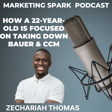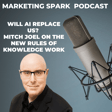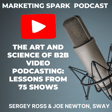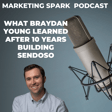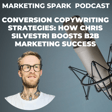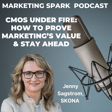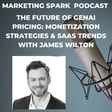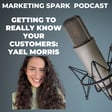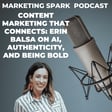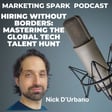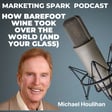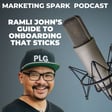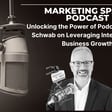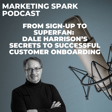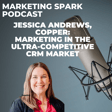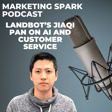Become a Creator today!Start creating today - Share your story with the world!
Start for free
00:00:00
00:00:01

A Deep Dive into the Fast-Growing Subscription Economy
The subscription economy is expected to grow from $15-billion this year to $475 billion by 2025. That's 68% year-over-year growth.
Adam Levinter operates in the eye of the hurricane as a subscription economy consultant, podcaster, and author.
In this episode of Marketing Spark, Adam and I explore why the subscription economy is growing so fast, the sectors seeing the most momentum, and how companies can embrace a subscription business.
We also take a look at how the subscription economy will impact marketing, which will focus on customer acquisition and, as important, customer nurturing.
Transcript
Introduction to Marketing Spark Podcast
00:00:03
Speaker
You're listening to Marketing Spark, the podcast that delivers insight, tools and tips from marketers and entrepreneurs in the trenches in 25 minutes or less.
What is the DTC Model?
00:00:13
Speaker
Many people may not be familiar with the direct-to-consumer sales model, but you've probably come across these types of companies. One of the best known is Dollar Shave Club, which sold razors and razor blades.
Who is Adam Vinter?
00:00:25
Speaker
It's a model gaining huge momentum as brands look to sell directly to consumers rather than going through middlemen such as online or bricks and mortar retailers.
00:00:34
Speaker
Adam Vinter has great insight into the direct-to-consumer model as a consultant, podcaster, and author.
Exploring DTC and Subscription Models
00:00:42
Speaker
Today, we're going to get into the DTC business and how it impacts marketing. Adam, welcome to Marketing Spark. Mark, it's so great to be here. Thanks for having me on.
00:00:52
Speaker
Let's start with the basics. What is the DTC or subscription economy? Can you describe how it works and why it's gaining so much momentum? Sure. DTC or D2C, I should say, is direct to consumer. That doesn't necessarily cover all subscription commerce companies. It's sort of the tip of the iceberg. What we talk about when we refer to the subscription economy is
00:01:15
Speaker
this derivative of DTC companies that are built on the back of subscribers.
What Drives the Subscription Economy?
00:01:24
Speaker
So if you think of companies like Amazon, Netflix, Spotify, Salesforce, you mentioned Dollar Shave Club, Barkbox and others, these are direct to consumer businesses that have built huge revenue on the back of a subscription type of model.
00:01:40
Speaker
And when we say the subscription economy, we're just talking about the companies or basket of companies that are using this model to drive growth. What's been interesting, well, let me go back a little bit. Probably a few years ago, I subscribed to a clothing company and every month they would send me clothes. And I don't really buy clothes that often, but it did give me a taste of what the subscription economy was all about. So I'm curious about what the driving factors are.
Why is Recurring Revenue Attractive?
00:02:10
Speaker
Brands trying to avoid the middleman is it brands trying to have ongoing relationships with consumers is it consumers wanting to have an ongoing experience with brands can you explain some of the underlying reasons why description economy is gaining momentum both among companies trying to embrace it and consumers that are obviously enthusiastic about it.
00:02:36
Speaker
From a company perspective, I would say that there are a few drivers here, the first being customer loyalty. In the age of Amazon, which is eating retail alive, you don't have a lot of customers who are loyal to brands anymore.
00:02:52
Speaker
And so companies are challenged to build that customer loyalty. And so rather than chasing transactions, they're building businesses that are driven on the relationship with the customer. And because subscription has a constant touch point with the customer, it's much easier to build that relationship long-term than it is if you're just selling them something once.
00:03:14
Speaker
The other thing that I would say is recurring revenue is also a big driver for companies. So just as I mentioned that it's difficult to build a business when you're selling them a product once, shifting to recurring revenue model gives you that sort of revenue consistency over time because the customer's opted into their subscription. So they're being billed for something, either billed for a product and that product is shipped or billed for a service on a monthly basis.
Are Subscription Models Suitable for All Businesses?
00:03:43
Speaker
So that recurring touch point means recurring revenue or more revenue over the long term and also that deepening of the relationship with the customer and i'd say from a consumer perspective you know the dollar shave club stories really interesting because they did a lot of things very well beyond just disrupting the incumbent they developed a very compelling brand story the marketing
00:04:04
Speaker
and video that went viral on youtube back in two thousand twelve where he got twelve thousand sign ups in twenty four hours or something like that that was a huge story i mean that had huge word of mouth effect. And beyond that you have this attraction from the customer to a brand that's disruptive to a brand that cares about the consumer that wants to develop that long term relationship and i would say the overarching thing here is personalization.
00:04:31
Speaker
And then we're talking about this element of convenience. If I'm annoyed that I have to go and shop for something on a consistent basis and go back to the site or go back to the store to replenish something that I'm running out of, subscription gives me a way around that. It gives me that convenience element that I want.
00:04:48
Speaker
You know, for a lot of people, subscriptions historically were around magazines or, you know, you'd get, you'd sign up and you'd get the magazine delivered month after month, year after year. What I find really interesting about the subscription economy is that.
00:05:02
Speaker
how it has become so broad. Who would have thought that buying it dress shirts or chocolate or bacon for that matter would be something that you would subscribe to. And I'm curious about how broad the subscription economy can
Growth Projections of the Subscription Market
00:05:16
Speaker
go. Can it apply to pretty much anything if there is consumer demand or is the subscription economy, does it play well in certain verticals, certain types of products?
00:05:27
Speaker
Yeah, so I get this question a lot from prospective clients. Subscription is not a model that works for every business. It doesn't work for every product. It doesn't work for every service. That said, how broad can it go? I would say it's broadening over time.
00:05:43
Speaker
we have incredible growth in the industry. We're at roughly 15 billion in terms of the global subscription e-commerce market right now. That's expected to grow to 478 billion by 2025. So that's a compound annual growth rate of roughly 68% over the period. And obviously there are industries within that growth that are accelerating. So
00:06:10
Speaker
beauty, cosmetics, and personal care is a big category for subscription. You have fashion and accessories and apparel. You've got food and beverage. You have connected fitness. You have media, music streaming. The list goes on. So I think that the categories are going to broaden over time.
Transitioning to Subscription-Based Models
00:06:30
Speaker
And we just continue to see growth ahead.
00:06:37
Speaker
Is this description model irresistible for many companies? The idea that instead of doing one-offs or a customer buys something two or three or four times a year, having that recurring steady, constant revenue coming in for a lot of companies,
00:06:53
Speaker
I mean that's unbelievable you look at the sass model for example i spend a lot of time working with b2b sass companies month after month you're after your people pay for the services companies pay for those services those digital services people love sass because once you get a customer as long as you service them properly then you'll probably keep them for a long time and my question to you is how aggressively are companies looking at subscriptions these days is it a model that they find increasingly difficult to ignore.
00:07:20
Speaker
I think it is. It's very expensive to attract a customer back after they've bought something once and shifting to a subscription model fundamentally changes the way you do business in that regard.
00:07:31
Speaker
because all of a sudden you're shifting the onus from merchant to the customer. And what I mean by that is when a customer signs up to a subscription, they are by default opting into something. And so they're assumed to be satisfied with whatever subscription they're signing up for over time, unless they decide to cancel.
00:07:51
Speaker
Rather than having the owners be on the merchant to constantly spend marketing dollars to attract that customer back back into the store back to the website whatever to make that report repurchase repeat purchase so i would say yeah it's very very difficult to ignore the appeal of this.
00:08:11
Speaker
Before we get into the mechanics of the subscription economy, I read that the subscription economy is a strategy that is people focused instead of protest focused and involves a shift in how companies view the product experience. Can you elaborate on that?
How to Determine Subscription Model Viability
00:08:26
Speaker
Yeah, I'd say legacy companies are run by old school thinkers, and those old school thinkers are driven by transactions. They're driven by volume of purchases, last quarter's results versus what this quarter can achieve. They really don't have a customer-centric point of view, and commerce is changing.
00:08:46
Speaker
We have, um, you know, we've got the background of the pandemic of course, but we're also moving to, uh, I'd say a much more relationship driven economy where consumers now have the power. Um, this wasn't the case 10, 20, 30 years ago. So yeah, shifting to this type of model fundamentally transforms how a company chooses to do business. And I think the appeal is there.
00:09:13
Speaker
So the $64,000 question is, how do you make the shift? For a company that has spent a lot of time focused on transactions, focused on one-offs or erratic spending by consumers, or maybe erratic's not the best word, but periodic spending by consumers, how does a company decide, I want to embrace the subscription economy. I recognize this is the way that business is going to be done going forward. This is the way that we're going to serve
00:09:37
Speaker
consumers consistently and it's going to be a win and win relationship, theoretically. So where do
Keys to Success in Subscription Businesses
00:09:43
Speaker
they start? How do they identify whether A, it has potential for their business and what are the first steps they should take to get going with the subscription economy? It's a variation on this question that I get asked a lot, which is, do you have a product or service or do I have a product or service that is potentially conducive to this model? So there's some nuance to answering this question, but in general, I'd say the first step
00:10:05
Speaker
is to ask yourself, can I create a subscription model that fits within one of the three broader subscription commerce categories? And those are one, replenishment, two, curation, and three, access. And I'll explain what each of these are.
00:10:23
Speaker
So replenishment is sort of the dollar shave club category. It's the Amazon subscribe and saves. It's that model where the merchant is selling the customer something that they're going to run out of every 30, 60, 90 days on average, and they're going to have to repurchase that product at a point of sale.
00:10:43
Speaker
I could be online or in store doesn't matter but that customer is gonna run out of that. Cream that peanut butter those diapers whatever those razors and they're gonna need to buy more do you have products.
00:10:58
Speaker
that fit this category? Are you selling consumables that customers run out of? That's replenishment. If the answer is yes, there's potential for a replenishment type of subscription play. Curation is the sort of second most popular, I'd say, product-driven category. And some examples are the bark boxes of the world Birchbox, Ipsy, some of these cosmetics brands that are doing
00:11:24
Speaker
these novelty sample type boxes and sending those to customers. So you know what you're getting in terms of the broader product categories. So a subscriber to Birchbox knows that he or she is signing up to a box of cosmetics. They just don't know exactly what they're getting. Same thing with Barkbox.
00:11:44
Speaker
If you're a dog owner, you know you're getting a dog toy and a treat of some kind every month. You don't know exactly what it's going to be. But that surprise and delight factor is there, and that keeps you hooked. So if you have products that you can curate that seem new and novel, where you can surprise and delight the customer, you have the potential for curation play. And the third is sort of the, I guess, the catch-all category, the access category.
00:12:12
Speaker
Do you have something that you can gate behind a paywall that's really compelling? Do you have a service that people are constantly paying for that's really appealing, that you could turn into some sort of subscription play? These companies that are driving the access model are the Netflixes of the world. Amazon Prime, all of the gym memberships, the online dating sites, the paid apps, the meditation apps like Calm or Headspace,
00:12:40
Speaker
education courses that are hidden behind a paywall online, content, a paid newsletter, something of that nature. So can you provide some sort of exclusive access to members only or to subscribers? And that's category number three.
00:12:57
Speaker
Once you've identified whether one of the categories apply to you, what a next step. You recognize the opportunity. You know, or think that your product can apply into one of these three buckets. Where do you start? Where do you start strategically? Where do you start tactically? How much preparation and strategic thinking do you have to do before you decide to launch this business model?
00:13:21
Speaker
Yeah. So I mean, that's the work
How Do Marketing Strategies Shift in Subscriptions?
00:13:24
Speaker
we do. It's not always easy. And I would say just in general that it's like starting any other business or business line. It does take some work. It takes some knowledge and know-how. It takes some combination of capabilities, systems, and tools to get the business off the ground.
00:13:40
Speaker
But the keys to success that I'll share, which I think are incredibly important, include the following. So number one, personalization. Personalization is key to the long-term success of these models. Subscription companies that generate more data on the consumer over time can offer more subsequent individualized offerings, can customize the customer experience, can develop that deeper relationship with the customer.
00:14:06
Speaker
The second thing is customer experience. So value-driven subscription models that address pain points that are associated with traditional incumbents have huge potential to disrupt and scale. So when you look at Dollar Shave Club as an example, the existing experience for men in terms of buying razors in a CVS, in a Walgreens, in a Shoppers Drug Mart, if you're in Canada, was incredibly annoying.
00:14:32
Speaker
And that's what Dollar Shave Club saw. So spotting that opportunity to disrupt the customer experience that has to be there. Can you carve out a good story? Can you do a good job with your marketing and storytelling? Creative, social-driven and influencer-based subscription companies are very, very, very successful.
00:14:52
Speaker
And it's because a lot of the customers who subscribe talk about that at the water cooler, right? It wasn't cool to talk about buying razors at a Walgreens before Dollar Shave Club came along. It made it very cool to talk about the newest subscription shaving club that you signed up for. And then customer service, I say is the fourth key thing. Start thinking about your customer service infrastructure.
00:15:16
Speaker
So subscription companies that have a balanced focus between customer acquisition and backend retention see way higher customer lifetime values over time and by default lower subscriber churn or cancellation rates.
00:15:28
Speaker
And I'll just share before we move on, I know I'm rambling a little bit, the common mistakes that people make when they jump into this space. Um, and those include, you know, things like category fit. So I think I can develop some sort of a subscription model, but it's just a bad category. For example, I sell men's shoes and I'm trying to sell men's shoes every month. That doesn't really work when men's men usually buy a pair of black shoes and a pair of Brown shoes once a year.
00:15:57
Speaker
Market timing, so is it a good time to launch in your industry or space? And then competition, of course, is there white space for you to launch and grow? Those are some three things that need to be considered.
00:16:09
Speaker
Great, that's a great overview in terms of what you should do and what you should avoid. One of the things that fascinates me as a marketer is how the subscription economy impacts marketing. So traditionally, we would be constantly in market, driving brand awareness, trying to nurture leads, trying to encourage people that our brand is better than other brands.
Why Are VCs Attracted to Subscription Revenue?
00:16:32
Speaker
But what happens when you have a ongoing relationship with a consumer
00:16:37
Speaker
Where you're not necessarily trying to win them again and again you already got them in the full what you're trying to do is support them encourage them provide them with confidence that. They're in the right relationship so that's one side of the coin the other marketing angle is that you got people who are subscribers yet.
00:16:54
Speaker
You may have to educate them. You may have to provide them with encouragement in terms of this is going to be a good experience. So how does the marketing mix change from being a very much of a transaction based organization to being subscription based? So it comes down in terms of customer acquisition and I'll flip to the customer retention or customer experience side. So in terms of bringing on new subscribers, we're always talking about one key metric here.
00:17:21
Speaker
And that is your lifetime value to CAC ratio or customer acquisition cost ratio. When you are acquiring customers, regardless of the channel that you're testing or you're acquiring that customer from, you're constantly optimizing for this particular KPI. No other KPI really matters.
00:17:43
Speaker
So if you have a lifetime value to CAC ratio of North of three to one, you're in good shape. That's typically the rule of thumb. I know I'll get some backlash or some feedback here from your listeners and say, no, there's more to it than that. Absolutely there is. But generally speaking, if you want a rule of thumb,
00:17:59
Speaker
LTV to CAC ratio of three to one or higher. If you are buying media, be it on Facebook or Instagram or Google ads or whatever you're doing, however you're split testing that marketing budget or however those dollars are breaking down, you want to be able to get clarity on what your LTV to CAC ratio is. On the other side of the equation, when we talk about nurturing the customer relationship,
00:18:26
Speaker
you're talking about other strategies to engage the customer and make them feel a part of the brand. That could be through email, that could be through text messaging, that could be through direct mail or cards. We talk about how interesting it was to see Chewie have this whole team of people writing Hallmark cards for their customers. There's lots of creative ways to do it, but
00:18:53
Speaker
Yeah, I'd say, you know, we're talking about two different things here, two sides of the coin, one side of it is customer acquisition. And then the other side is, how does it work in terms of nurturing that customer experience. But what I will say, the last thing I'll say about this market, I think it's an important thing to note is, once you've acquired that subscriber, that CPA that that cost is
00:19:18
Speaker
that's accounted for. You now have that subscriber for subsequent months, hopefully for years if they're very sticky. So that upfront cost that you pay for that consumer, that's a one-time hit versus a transactional driven model where each time you acquire a customer, that has a customer acquisition cost to it.
00:19:40
Speaker
Yeah, it's interesting that you brought up Chewie and the fact that Ryan Cohen has been in the news a lot. Ryan, who was the co-founder of Chewie, was a big investor in GameStop, and I'm sure he's got a lot of capital these days to invest in subscription economy companies if he wants to. So that's a nice segue into the whole venture capital subscription economy relationship, because you're seeing a tremendous amount of money being poured into these type of companies.
00:20:06
Speaker
And the obvious question to you is why do venture capital firms and private equity firms for that matter like subscription economies is it the consistency of the business model the reliability of how these companies operate what makes them so attractive to investors.
00:20:22
Speaker
In terms of being attracted to the subscription economy in general, it's that growth rate that's expected. So we're at 15 billion, like I mentioned, we're expected to grow to 478 billion by 2025. There are categories within that growth basket of companies that are going to be growing at such a clip. So they're obviously attracted to the industry.
00:20:46
Speaker
In terms of being attracted to the actual specific companies, what many of these firms look for beyond product market fit, a good team, solid growth, et cetera, are three factors. One is recurring revenue, two is customer loyalty, and three is predictable cashflow. And a subscription business provides all three of those things, if you think about it.
00:21:09
Speaker
And if you are an owner of a fast scaling company or if you're thinking about starting a company and you're asking yourself sort of what impact does this have on valuation, if any, what we're seeing is really interesting, where right now an acquirer is paying
00:21:25
Speaker
And I know there's multiple ways to value companies, multiples on EBITDA, top line, I get that. But if you're thinking about what kind of impact a transition to recurring revenue might have on your business, I think it's important to note this fact. So, acquirers are paying about 75 cents for every dollar of one-time transactional revenue, yet they're dishing out $3 for every dollar of recurring revenue.
Subscription Models vs. Loyalty Programs
00:21:50
Speaker
In other words, dollar for dollar, a subscription-based business is worth 3X, what a transactional one is.
00:21:58
Speaker
Well, the economics are compelling and you can totally understand why a lot of venture companies are killing themselves to get involved with some of these companies. And it will be interesting, just like the original e-commerce evolution to see how the subscription economy from an investment perspective stands out. One of the things that I wanted to circle back on when it comes to marketing is point programs, loyalty programs that are run by traditional retailers. Like the more you shop there, the more points you get.
00:22:24
Speaker
What is the subscription economy say about the future of the points economy? Is one going to kill the other? Can you combine the two? What's your take on how loyalty programs will evolve going forward?
00:22:38
Speaker
Amazon Prime, which is arguably the most successful subscription business ever created, has prompted a lot of established brands to rethink the structure of their existing loyalty programs. Five, 10, 15 years ago, points programs were very popular. At one point, they were ubiquitous. Moving forward, I don't think it's going to be that way. I think loyalty programs look a lot more like Prime. Free points programs, they look good on the surface, but
00:23:07
Speaker
they're really, again, this is sort of a merchant driven or company driven approach to loyalty versus a consumer driven one. And when I say that, if you look at what's happening with these points programs, they have long redemption times. Let's use air miles as an example to just give people a clear picture of what we're talking about here.
00:23:32
Speaker
So if we look at error miles, long redemption times, poor awareness and understanding of the benefits and anemic usage, we don't see people using or redeeming their points a lot. Some people like to use the term breakage, which is a fancy way of saying, you know, here's something we're giving the customer that they don't use. Breakage is extremely high with points programs.
00:23:56
Speaker
Whereas on the flip side, if we look at Amazon Prime, we've got a paid opted in VIP style subscription where brands get the benefit of a predictable source of recurring revenue. In the case of Prime, that's an annual membership fee of 80 bucks or a hundred bucks or whatever it is now.
00:24:17
Speaker
which can be used to subsidize more benefits that go into that program, like free shipping, like additional coupons, like access to Prime Video, all these things. So in turn, customers receive way more value.
00:24:32
Speaker
become way more engaged and they use the programs more frequently and ultimately spend more money.
Reflections on Subscription Economy Growth
00:24:39
Speaker
And from Prime to Instacart to Restoration Hardware's Prime-like VIP program, the numbers back it up. Instacart's building
00:24:49
Speaker
loyalty and engagement through their fee for VIP subscription program. It's called Instacart Express, I think. The numbers are incredibly promising where the average Instacart shopper is spending about $95 in order, which is roughly $2,300 a year, whereas Express customers, on the other hand, who are paying 99 bucks a year for free deliveries are ordering twice as often and spending $5,000 a year. And if we just go back to Amazon Prime, same thing.
00:25:16
Speaker
Typical Amazon shoppers spend $700 a year. Prime shoppers are spending double that.
00:25:23
Speaker
When we originally talked about having this podcast conversation, I understood that the subscription economy was growing and you hear stories about Barkbox and Dollar Shave Club and other companies that are experiencing really good growth. But when you look at the 68% year over year compound growth over the next five years from going from a $15 billion to a $500 billion industry, it is astounding.
00:25:48
Speaker
It's gonna be really interesting to see how things evolve who the winners are who's gonna lose and i'm sure you're gonna have a good ride as a consultant and someone who helps companies get into the subscription economy.
Resources: Adam Vinter's Book and Podcast
00:26:00
Speaker
It's gonna be fascinating to be in the either hurricane so one final question where can people learn more about you your services and your podcast.
00:26:08
Speaker
So they can learn more at scriberbase.com. That's like subscriber without the sub, scriberbase.com for more. They can link to the podcast that I host off of Scriberbase or find my podcast wherever they get their audio. So my podcast is called E2 Entrepreneurs Exposed and I interview founders of incredible businesses on the show.
00:26:32
Speaker
And yeah, I would also recommend people dive into some of the articles and research that is coming out on the subscription space. Forbes is writing about the space a lot. Entrepreneur Inc. Wired Zora out of San Francisco has a ton of great content on subscription. So I'd encourage people to read more. And one other thing that you failed to mention is that you have a book that you published recently.
00:26:59
Speaker
Yes. My first book, it's called the subscription boom. Why an old business model is the future of commerce. It's available everywhere. Unfortunately with COVID, a lot of stores are closed, but it is on business bookshelves and on Amazon.
Conclusion and Call to Action
00:27:14
Speaker
Awesome, Adam. Well, thanks for your time and thanks for everyone for listening to another episode of Marketing Spark. If you enjoyed the conversation, leave a review and subscribe via iTunes or your favorite podcast app. For show notes of today's conversation and information about Adam, visit marketingspark.co. If you'd like to learn more about how I help B2B SaaS companies as a fractional CMO, consultant and advisor, send an email to mark at marketingspark.co. I'll talk to you next time.
